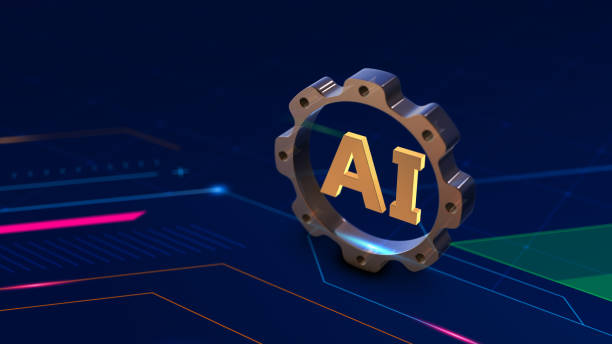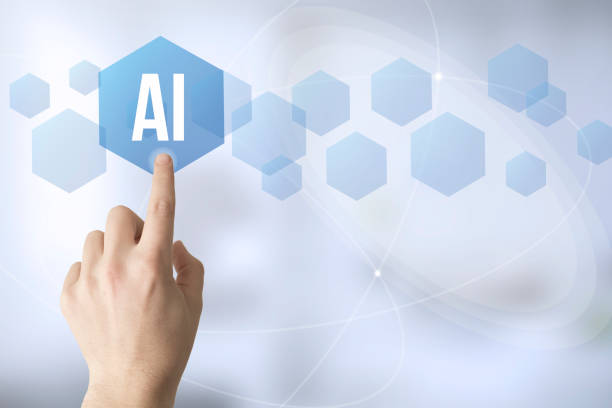What is Artificial Intelligence and How Does It Work?

#Artificial_Intelligence (AI) is a branch of computer science that seeks to create machines that can perform tasks that usually require human intelligence.
These tasks include learning, reasoning, problem-solving, understanding natural language, and pattern recognition.
In general, artificial intelligence tries to design systems that can think, learn, and act like humans.
Artificial intelligence uses complex algorithms and mathematical models to process data and extract patterns.
These algorithms allow machines to learn from data and make decisions.
For example, a face recognition system using deep learning algorithms can identify different faces from images.
This process involves analyzing different facial features and comparing them with a database of known faces.
Wikipedia can provide more information in this field.
Artificial intelligence falls into two general categories: Weak AI (Narrow AI) and Strong AI (General AI).
Weak AI is designed to perform a specific task, such as facial recognition or language translation.
In contrast, Strong AI seeks to create machines that can do anything a human can do.
Achieving Strong AI is still a major challenge, and currently most AI systems are of the Weak AI type.
The ultimate goal in the development of artificial intelligence is to create systems that are not only capable of performing specific tasks, but can also learn, reason and make decisions independently.
Currently, artificial intelligence is used in various industries including medicine, finance, transportation and manufacturing and has a significant impact on our daily lives.
Did you know that 94% of first impressions of a company are related to its website design?
Rasaweb helps you create the best first impression by providing professional corporate website design services.
✅ Creating a professional and reliable image of your brand
✅ Easier attraction of potential customers and improved online position
⚡ Get free corporate website design consultation
Types of Machine Learning Algorithms in Artificial Intelligence

Machine Learning is a subset of artificial intelligence that allows machines to learn from data without explicit programming.
Machine learning algorithms are generally divided into three main categories: Supervised Learning, Unsupervised Learning, and Reinforcement Learning.
In supervised learning, the model is trained using labeled data.
This means that each input data is accompanied by a correct label indicating what the expected output is.
The algorithm tries to learn a function or model that can correctly map the input data to the corresponding labels.
Examples of supervised learning algorithms include linear regression, decision trees, and neural networks.
Supervised learning is used for problems such as spam detection, image recognition, and stock price prediction.
In unsupervised learning, the model is trained using unlabeled data.
In this case, the goal is to find hidden patterns and structures in the data.
Unsupervised learning algorithms can be used for clustering data, reducing dimensions, and detecting anomalies.
Examples of unsupervised learning algorithms include K-means clustering, principal component analysis (PCA), and association algorithms.
Unsupervised learning is used for problems such as customer segmentation, fraud detection, and market basket analysis.
Reinforcement learning is a different approach in which an agent operates in an environment and learns based on the feedback it receives.
The agent tries to learn an optimal policy that allows it to maximize its reward.
Reinforcement learning is used for problems such as video games, robotics, and decision-making optimization.
Examples of reinforcement learning algorithms include Q-learning and deep reinforcement neural networks.
These methods are currently used in many artificial intelligence applications.
Applications of Artificial Intelligence in Everyday Life

Artificial intelligence (AI) has increasingly penetrated our daily lives and is used in various fields including homes, workplaces and entertainment.
One of the most common applications of artificial intelligence is voice assistants such as Siri, Alexa and Google Assistant.
These assistants can answer our questions, play music, set reminders, and control smart home devices.
In smart homes, artificial intelligence is used to control lighting, temperature and security.
Smart thermostats can learn your habits and automatically adjust the temperature to optimize energy consumption.
Smart security systems can detect suspicious activity and alert you.
Also, robot vacuum cleaners can automatically clean the floors of houses.
These technologies not only make our lives easier, but also help reduce costs.
In the workplace, artificial intelligence is used to automate repetitive tasks, improve productivity and make better decisions.
Artificial intelligence-based customer relationship management (CRM) systems can analyze customer information and help sales and marketing teams adopt better strategies.
Industrial robots can perform dangerous and repetitive tasks and prevent accidents.
Also, artificial intelligence can help in analyzing big data and identifying hidden patterns, which helps managers in strategic decision-making.
In the field of entertainment, artificial intelligence is used to suggest movies and music, create custom content and improve the gaming experience.
Music streaming services like Spotify and Apple Music use artificial intelligence algorithms to suggest songs you might like.
Movie streaming services like Netflix and Amazon Prime Video use artificial intelligence to suggest movies and series that match your taste.
Also, artificial intelligence can help in creating more realistic and challenging video games.
th, td {
border: 1px solid #ddd;
padding: 8px;
text-align: left;
}
th {
background-color: #f2f2f2;
}
| Application | Description |
|---|---|
| Voice Assistants | Answering questions, playing music, setting reminders |
| Smart Homes | Controlling lighting, temperature, security |
| Workplace | Automating tasks, improving productivity |
| Entertainment | Suggesting movies and music, creating content |
Artificial Intelligence and the Future of Jobs

Artificial intelligence (AI) is dramatically changing the landscape of jobs and will have far-reaching impacts on the labor market.
While artificial intelligence can automate many repetitive and simple tasks, this technology also provides new opportunities to create new jobs and improve productivity in various industries.
One of the biggest concerns about artificial intelligence is the replacement of human jobs.
In fact, some jobs that involve repetitive and routine tasks are likely to be fully automated.
This includes jobs such as telephone operators, data entry clerks, and some manufacturing jobs.
However, artificial intelligence can also help create new jobs that require specialized skills.
For example, the demand for data scientists, machine learning engineers, and artificial intelligence specialists is increasing.
These individuals are responsible for designing, developing, and implementing artificial intelligence systems.
In addition, artificial intelligence can help improve productivity in various industries.
By automating repetitive tasks, employees can spend more time on creative and strategic work.
For example, in the medical industry, artificial intelligence can help doctors diagnose diseases and provide personalized treatments.
In the financial industry, artificial intelligence can help analysts identify fraud patterns and manage risk.
To prepare for the future of jobs in the age of artificial intelligence, people need to learn new skills that are aligned with the needs of the labor market.
This includes technical skills such as programming, data analysis, and machine learning, as well as soft skills such as critical thinking, problem-solving, and communication.
Education plays an important role in preparing individuals for the jobs of the future.
Universities and educational institutions should update their curricula to teach students the skills needed to work in the age of artificial intelligence.
Also, governments and organizations should increase investment in education and skills development so that the workforce can adapt to the changes brought about by artificial intelligence.
Are you tired of your online store not generating as much revenue as it potentially could? Rasaweb, a specialist in professional online store design, solves this problem forever!
✅ Increase sales and revenue significantly
✅ Fast loading speed and unique user experience
⚡ Get free online store design consultation
Challenges and Limitations of Artificial Intelligence

Artificial intelligence (AI), despite its impressive progress, still faces numerous challenges and limitations that prevent it from fully realizing its potential.
One of the biggest challenges is the need for large and high-quality data to train artificial intelligence models.
Machine learning algorithms require huge amounts of data to learn patterns and relationships in the data.
If the data is incomplete, incorrect, or biased, artificial intelligence models cannot learn correctly and provide accurate results.
In addition, interpretability is another important challenge in artificial intelligence.
Many complex artificial intelligence models, such as deep neural networks, act like black boxes.
This means that it is difficult to understand why an artificial intelligence model has made a particular decision.
This issue can be problematic in applications that require transparency and accountability, such as medicine and law.
Ethical issues are also an important aspect of artificial intelligence development.
The use of artificial intelligence can lead to discrimination, violation of privacy, and reduction of human autonomy.
For example, artificial intelligence algorithms used to make decisions about hiring, granting loans, or determining penalties may unintentionally be discriminatory.
Also, the collection and use of personal data by artificial intelligence systems can lead to privacy violations.
Security is also a fundamental challenge in artificial intelligence.
Artificial intelligence systems can be vulnerable to cyber attacks.
Hackers can manipulate input data or change algorithms to deceive artificial intelligence systems and obtain incorrect results.
This issue can be dangerous in applications that require high security, such as self-driving cars and defense systems.
To overcome these challenges and limitations, more research and development of ethical and legal standards are needed to ensure the responsible and safe use of artificial intelligence.
The Future of Artificial Intelligence and Its Impact on Society

The future of artificial intelligence (AI) is very bright and full of possibilities, and this technology is predicted to have a profound impact on various aspects of society.
With continuous advances in the fields of machine learning, natural language processing, and computer vision, artificial intelligence will increasingly be able to perform more complex tasks and make better decisions.
One of the most important impacts of artificial intelligence on society is changes in the labor market.
As mentioned earlier, artificial intelligence can automate many repetitive and routine tasks, which may lead to the loss of some jobs.
However, artificial intelligence can also provide new opportunities to create new jobs and improve productivity in various industries.
To prepare for these changes, people need to learn new skills and adapt to new technologies.
Artificial intelligence can help improve the quality of life for individuals.
In the field of healthcare, artificial intelligence can help doctors diagnose diseases, provide personalized treatments, and improve patient outcomes.
In the field of education, artificial intelligence can help teachers provide customized and individualized education to students.
In the field of transportation, artificial intelligence can help reduce traffic, improve safety, and reduce air pollution.
th, td {
border: 1px solid #ddd;
padding: 8px;
text-align: left;
}
th {
background-color: #f2f2f2;
}
| Field | Impacts of Artificial Intelligence |
|---|---|
| Healthcare | Diagnosing diseases, providing personalized treatments |
| Education | Customized education, improving student outcomes |
| Transportation | Reducing traffic, improving safety |
| Environment | Reducing air pollution, managing resources |
In addition, artificial intelligence can help solve global problems such as climate change, poverty, and hunger.
By using artificial intelligence, innovative solutions can be found for these problems and resources can be managed more effectively.
However, the development and use of artificial intelligence must be done with care and responsibility.
It must be ensured that artificial intelligence is used for the benefit of all members of society and that discrimination, violation of privacy, and reduction of human autonomy are prevented.
Also, appropriate ethical and legal standards should be developed for the development and use of artificial intelligence to prevent abuse of this technology.
The Role of Data in Artificial Intelligence Training

Data plays a vital role in artificial intelligence (AI) training.
Machine learning algorithms require huge amounts of data to learn patterns and relationships in the data.
The more data there is and the higher its quality, the more accurately artificial intelligence models can learn and provide better results.
In general, data acts as fuel for the artificial intelligence engine.
Without sufficient and appropriate data, artificial intelligence systems cannot function properly.
Various types of data can be used for artificial intelligence training, including text data, image data, audio data, and numerical data.
Text data can be used to train natural language processing models, which can be used for language translation, text summarization, and question answering.
Image data can be used to train computer vision models, which can be used for facial recognition, object detection, and medical image analysis.
Audio data can be used to train speech recognition models, which can be used for speech-to-text conversion, speaker identification, and emotion analysis.
Numerical data can be used to train prediction models, which can be used for stock price prediction, sales forecasting, and fraud prediction.
Collecting, preparing, and managing data is one of the most important steps in artificial intelligence training.
Data must be collected from various sources, cleaned, transformed, and organized to be suitable for training artificial intelligence models.
This process can be time-consuming and expensive, but it is necessary to ensure the quality and accuracy of artificial intelligence models.
In addition, maintaining data privacy and security is also an important issue in artificial intelligence training.
It must be ensured that personal data is stored securely and protected from unauthorized access.
Also, the use of data for discriminatory or illegal purposes must be prevented.
The use of data in artificial intelligence requires attention to ethical and legal issues.
Artificial Intelligence and Natural Language Processing

Natural Language Processing (NLP) is a branch of artificial intelligence (AI) that seeks to create systems that can understand, interpret, and generate human language.
This includes the ability to read, write, speak, and interact with humans in natural language.
Natural language processing uses algorithms and machine learning models to analyze and process language data.
These algorithms allow systems to learn grammatical rules, word meanings, and sentence structures.
One of the important applications of natural language processing is machine translation.
Machine translation systems can translate text or speech from one language to another.
This technology is currently used in online translation services such as Google Translate and Bing Translate and helps people communicate with people who speak different languages.
In addition to machine translation, natural language processing is also used in content production.
Automated content generation systems can automatically generate articles, reports, and other types of content.
This technology can help companies produce large volumes of content quickly and at a low cost.
Sentiment analysis is also another important application of natural language processing.
Sentiment analysis systems can detect people’s emotions and opinions from text, speech, or social media.
This technology can help companies collect and analyze their customers’ opinions about their products and services.
Natural language processing is also used in chatbots and virtual assistants.
Chatbots and virtual assistants can interact with humans in natural language, answer their questions, and perform various tasks.
This technology is currently used in customer service, sales, and technical support.
Are you tired of your online store having visitors but no sales? Rasaweb solves your main problem with professional online store design!
✅ Significant increase in sales with targeted design
✅ Perfect user experience for your customers
⚡ Get a free consultation!
Security in Artificial Intelligence

Security in artificial intelligence (AI) is a very important and growing topic that becomes more important with the increasing use of artificial intelligence systems in various industries.
Artificial intelligence systems can be vulnerable to cyber attacks, and these attacks can lead to data theft, data manipulation, and system malfunction.
One of the common vulnerabilities in artificial intelligence systems is Adversarial Attacks.
In this type of attack, attackers manipulate the input data in such a way that the artificial intelligence system makes incorrect decisions.
For example, an attacker can change an image in such a way that an image recognition system misidentifies it.
In addition to adversarial attacks, artificial intelligence systems can also be vulnerable to Model Stealing attacks.
In this type of attack, attackers try to obtain a copy of the artificial intelligence model and use it for malicious purposes.
For example, an attacker can steal a facial recognition model and use it to identify people without their permission.
Data privacy is also another important issue in artificial intelligence security.
Artificial intelligence systems are often trained with a lot of personal data, and this data can be at risk.
Attackers can extract sensitive information about individuals by accessing the training data.
For example, an attacker can access the medical data of an artificial intelligence system to obtain personal information about patients.
To address these challenges, various methods should be used to increase the security of artificial intelligence systems.
This includes using defensive techniques against adversarial attacks, protecting artificial intelligence models against model stealing attacks, and ensuring data privacy.
Also, appropriate security standards should be developed for the development and use of artificial intelligence systems to prevent abuse of this technology.
For more information on cybersecurity, you can refer to Wikipedia.
How to Start Learning Artificial Intelligence

Learning artificial intelligence (AI) can be an exciting and rewarding journey.
However, getting started may be daunting for many people.
To start learning artificial intelligence, you must first familiarize yourself with its basic concepts and principles.
This includes understanding concepts such as machine learning, neural networks, optimization algorithms, and natural language processing.
There are many resources for learning these concepts, including books, online courses, video tutorials, and scientific articles.
After familiarizing yourself with the basic concepts, you should learn a programming language that is suitable for developing artificial intelligence systems.
Python is one of the most popular programming languages for artificial intelligence because it has rich libraries and powerful tools that make it easier to develop artificial intelligence systems.
In addition to Python, other languages such as R, Java, and C++ can also be used to develop artificial intelligence systems.
After learning a programming language, you should familiarize yourself with important artificial intelligence libraries and tools.
Some of the popular artificial intelligence libraries include TensorFlow, Keras, PyTorch, and scikit-learn.
These libraries provide tools for building, training, and evaluating artificial intelligence models.
In addition, other tools such as Jupyter Notebook and Google Colab can also be useful for developing and testing artificial intelligence code.
To gain practical experience, you should do small and simple artificial intelligence projects.
This could include building a simple image recognition system, a stock price prediction system, or a question answering system.
By doing projects, you can improve your skills in the field of artificial intelligence and face real-world challenges.
You can also participate in online courses to complete your knowledge.
FAQ
| Question | Answer |
|---|---|
| 1. What is Artificial Intelligence (AI)? | It is a branch of computer science that aims to create machines capable of simulating human intelligence and performing tasks that require human thinking, such as learning, problem-solving, and decision-making. |
| 2. What are the main types of artificial intelligence? | They can be classified into weak artificial intelligence (Narrow AI) that focuses on a specific task, general artificial intelligence (General AI) that has comprehensive human capabilities, and super artificial intelligence (Super AI) that exceeds human intelligence. |
| 3. Mention some common artificial intelligence applications in our daily lives. | They include voice assistants (such as Siri and Alexa), recommendation systems (such as Netflix and Amazon), self-driving cars, facial recognition systems, and spam filters. |
| 4. What is the difference between artificial intelligence and machine learning (Machine Learning)? | Artificial intelligence is the broader concept of creating intelligent machines, while machine learning is a subset of artificial intelligence that focuses on enabling systems to learn from data without explicit programming. |
| 5. What is Deep Learning? | It is a subset of machine learning that uses multi-layered artificial neural networks (deep neural networks) to process data and discover complex patterns, and is used in image and speech recognition. |
| 6. What are the most prominent benefits of artificial intelligence? | Improving efficiency and productivity, automating repetitive tasks, making better decisions based on big data analysis, and developing solutions to complex problems in fields such as medicine and science. |
| 7. What are the main challenges facing the development and deployment of artificial intelligence? | They include the need for huge amounts of high-quality data, privacy and security issues, bias in data and algorithms, and high development and maintenance costs. |
| 8. Does artificial intelligence raise ethical or social concerns? | Yes, it raises concerns related to privacy, algorithmic bias, job loss due to automation, responsibility for errors made by intelligent systems, and the need for a regulatory framework. |
| 9. How can artificial intelligence affect the future of the labor market? | It can lead to the automation of some routine jobs, but it will also create new jobs that require advanced skills in developing, operating, and maintaining artificial intelligence systems. |
| 10. What are some modern or promising technologies in the field of artificial intelligence? | They include advanced natural language processing (NLP) (such as large language models like ChatGPT), computer vision, robotics, and generative artificial intelligence (Generative AI). |
And other services of Rasa Web Advertising Agency in the field of advertising
Intelligent data analysis: an effective tool for digital branding with the help of marketing automation.
Intelligent UI/UX: Professional optimization for campaign management using dedicated programming.
Intelligent customer journey map: a dedicated service for growing customer acquisition based on SEO-oriented content strategy.
Intelligent social media: an effective tool for online growth with the help of marketing automation.
Intelligent marketing automation: a fast and efficient solution for analyzing customer behavior with a focus on Google Ads management.
And more than hundreds of other services in the field of internet advertising, advertising consulting and organizational solutions
Internet advertising | Advertising strategy | Reportage advertising
Resources
What is artificial intelligence and how does it work?
,What is artificial intelligence?
,What is artificial intelligence? Everything you need to know about AI.
,What is artificial intelligence and what are its applications?
? Have a powerful and influential presence in the online world with Rasaweb Afrin, a specialist in corporate website design, SEO and digital marketing.
📍 Tehran, Mirdamad Street, next to the Central Bank, South Kazerun Alley, Ramin Alley No. 6




